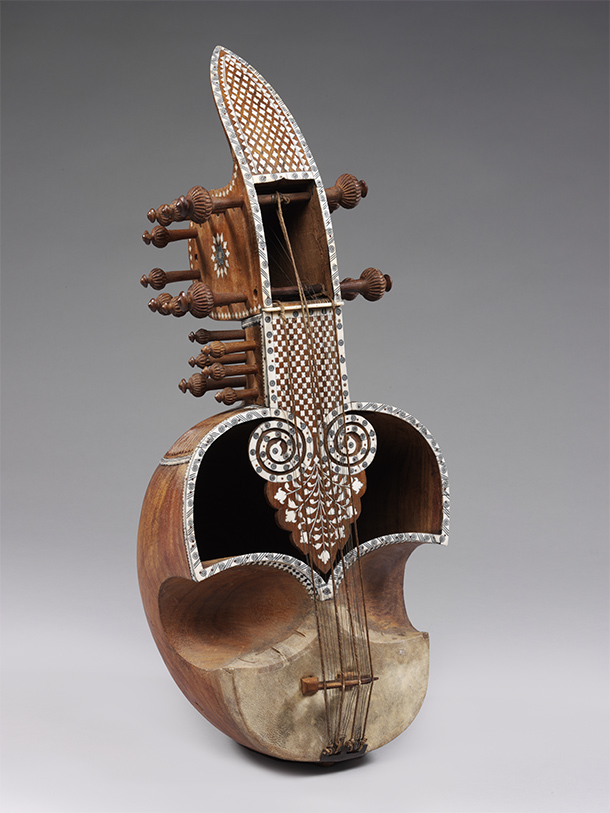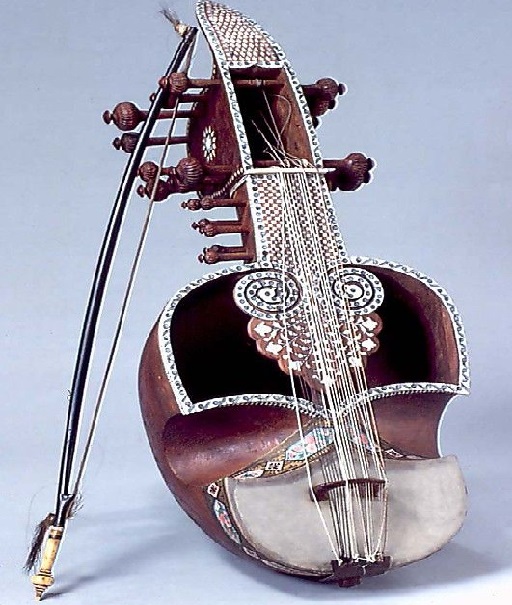Sarinda
Bowed Instruments
Asia
Between 1001 and 1900 AD
Video
The sarinda, also known as saranda, is a traditional stringed instrument predominantly found in North and Eastern India, as well as parts of Pakistan. It is classified as a bowed string instrument and shares similarities with other instruments like the sarangi and the fiddle. The sarinda is characterized by its unique construction, which typically involves a single block of wood, three primary strings (two made of steel and one gut string), and an intricate arrangement of sympathetic strings that enhance its resonance. This instrument is played in a vertical position, often resting on the musician’s leg, and is essential in various folk music traditions across the region.
Historical Context
The origins of the sarinda can be traced back to the Sikh culture, where it was popularized by Guru Arjan, the fifth Sikh guru, who incorporated it into kirtan (devotional singing). The instrument has deep roots in Indian history, with references dating back to at least the 16th century. Its design and playing style have evolved over centuries, influenced by various cultural exchanges across South Asia. The sarinda’s significance extends beyond its musical capabilities; it serves as a cultural symbol for many ethnic groups in India, including the Bauls of Bengal, Punjabi folk artists, and various tribal communities. In 2022, it received a Geographical Indication (GI) certificate, recognizing its unique cultural heritage.
Structure and Mechanism
The sarinda’s construction is both functional and artistic. It features:
Body: Typically heart-shaped with a narrow waist.
Strings: Three main strings (two steel and one gut) along with up to thirty-six sympathetic strings that vibrate in harmony with the played notes.
Resonating Chamber: The body of the instrument is partially covered with animal skin, which contributes to its distinctive sound quality.
To play the sarinda, musicians use a bow made from horsehair. The technique involves drawing the bow across the strings while simultaneously pressing on them with fingers to create varied pitches. This allows for expressive melodies that are characteristic of folk music.
Types of Sarinda
There are several variations of the sarinda based on regional styles and specific uses:
Ordinary Sarinda: The most common form with three main strings.
Sanyogi Sarinda: Features four gut strings and is traditionally played by yogis and ascetics.
Boro Sarinda: Used by the Boro people in Assam, showcasing unique regional characteristics.
Surando: An ancient version found primarily in Sindh and Kutch regions.
Each type reflects the cultural nuances of its respective community while maintaining the core attributes of the sarinda.
How to Play Sarinda
The Sarinda is a traditional bowed string instrument widely used in South Asia, particularly in India, Pakistan, Nepal, and Afghanistan. It is a folk instrument, often associated with tribal music, Sufi traditions, and local rituals. The Sarinda has a hollow, rounded body, typically carved from wood, with a skin membrane covering the resonator. It features three to four main playing strings, often made from gut or metal, and sometimes includes additional sympathetic strings to enrich its sound. Playing the Sarinda involves using a bow to create resonant, expressive tones. The instrument is held vertically, with the base resting on the player’s lap. The left hand presses the strings on the fretless neck, adjusting pitch, while the right hand controls the bow’s movement to produce sound. The technique requires precision, as the sympathetic strings can vibrate freely, adding a layer of harmonic richness to the music. The Sarinda is known for its melancholic and soulful tone, which makes it particularly suited for devotional and emotional compositions.
In terms of music, the Sarinda is used to accompany folk songs, dance performances, and narrative storytelling. It often follows traditional ragas and folk scales, allowing for improvisation and expressive playing. Compositions for the Sarinda are typically passed down orally, reflecting its deep roots in oral traditions. In Sufi music, the Sarinda is used to evoke a spiritual connection, accompanying poetry and chants that inspire devotion. Despite being less common today, it continues to play an important role in preserving the cultural heritage of the regions where it is used.
Musical Significance
The music produced by the sarinda ranges from devotional hymns to lively folk tunes. It plays a crucial role in various ceremonies and celebrations, often accompanying dance performances. The instrument’s ability to convey deep emotions makes it a favorite among folk musicians who use it to tell stories through their songs.In addition to its role in secular music, the sarinda holds spiritual significance in many traditions. It is often used during religious rituals and gatherings, reinforcing its importance in both cultural and spiritual contexts.
The sarinda stands as a testament to India’s rich musical heritage. Its unique construction, historical roots, and cultural significance make it not just an instrument but a vital part of community identity across Northern India and beyond. As it continues to be played and celebrated today, the sarinda remains an enduring symbol of folk music’s power to connect people through shared traditions.
FAQ
What is the Sarinda and its significance in Indian music?
The Sarinda is a traditional bowed string instrument originating from India, known for its resonant and soulful sound. It is often used in folk and tribal music, particularly in regions like Rajasthan and Punjab. The instrument has cultural and ceremonial significance, frequently played during festive occasions and rituals. Its unique design and sound make it a symbol of India's rich musical heritage.
What are the key features of the Sarinda's construction and design?
The Sarinda typically features a hollow wooden body with a skin-covered soundboard. Its shape resembles a boat or half-moon, contributing to its distinct tonal quality. The instrument has three to four main strings, traditionally made from gut or metal. It is played using a bow and is known for its rich, haunting melodies. Ornate carvings often decorate the instrument, reflecting regional aesthetics.
How does the Sarinda contribute to Indian folk and tribal music?
The Sarinda plays a vital role in Indian folk and tribal music by providing melodic accompaniment to dances, storytelling, and rituals. Its evocative tones enhance the emotional depth of performances, creating a connection between the performers and the audience. The instrument often accompanies vocal music, blending seamlessly with traditional rhythms. Its portability and expressive range make it a favorite among rural musicians.
 Links
Links
References
Other Instrument
Categories



















